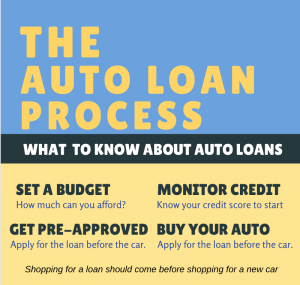Unless you have a hefty savings account, buying a car with cash is probably not something you’re able to do. So what do you do when you need a new car, but don’t have the money saved up to pay for it? You get an auto loan.
Auto loans have many different elements, and that can make them feel overwhelming initially. Car dealers also like to present the parts of the auto loan agreement that look favorable to customers, such as the low monthly payment, and hide away the rest, such as the much higher interest rate.
Customers looking at buying a car should shop around not only for the best deal on the auto they are considering, but also for the auto loan they are going to use to pay for it. Relying on the dealership to give them the best auto loan terms is a serious gamble that rarely pays off. Fortunately, you can learn what you need to know about auto loans and how to find one that suits your needs before you even step foot in the dealership.
The Basics of Auto Loans
An auto loan is a personal loan secured by collateral – namely, the car itself. The lender offers you a lump sum of money that is tied to the vehicle itself. You accept the funds and agree to pay interest as the cost for borrowing the money. You then repay the loan plus interest in monthly payments for the length of the loan terms – usually anywhere from 24 months to 72 months.
There are some personal loans that are unsecured loan. An unsecured loan is not tied to the collateral, but rather borrowed based on your own credit history and trustworthiness. In the case of auto loans, however, your car is your collateral. If you fail to make timely payments, the lender will simply take your car as payment for the loan debt.
The Parts of an Auto Loan
There are three essential parts to any auto loan: the principal, the interest and the down payment. The principal is how much you are borrowing. If your new car costs $20,000, the principal of the loan would be $20,000.
The interest is how much the bank is charging you to borrow the money. This rate can vary wildly. Some auto loans have zero percent interest, or no interest at all, if they are financed through a special promotion at a car dealership. Others can have interest closer to 20 percent. The monthly payment you make on the loan varies tremendously based on the interest rate you’re paying.
The higher the interest rate, the bigger the payment, and the more you’ll ultimately pay for the auto loan. That $20,000 car loan with 5 percent interest will ultimately cost you $22,645 over 60 months. At 20 percent interest, that same car loan will cost you $31,793. Interest rates make a huge difference.
The final consideration for an auto loan is the down payment. If your car is $20,000 and you put nothing down as a down payment, you will need a loan for $20,000. If you put $2,000 down on the new auto, your loan principal is reduced to $18,000. Most auto loans require some amount as down payment.
The Auto Loan Process
There are basic steps you will follow when you’re working to set up a new auto loan. The process does not start with finding a new car, however. In fact, shopping for a loan should come before shopping for a new car.

Step 1: Set an auto loan budget.
How much can you afford to spend on a new auto loan? There are multiple calculators online that help you determine how a monthly payment translates into a total car price.
Step 2: Monitor your credit.
Your auto loan interest rate and terms are going to be closely tied to your credit score. If you haven’t checked your credit score lately, check it before you start applying for new auto loans.
Step 3: Get pre-approved for a good auto loan deal.
You’ll need to shop around a bit to see what terms lenders are offering. You can get a good idea by checking interest rates online before even applying for pre-approval. Apply for the loan before you shop for the car. That way you know how much you can spend, and you will effectively have the cash in hand.
Step 4: Buy the new car.
Once you know your budget, you’ve been approved and you are working with a lender, head to the dealership. Find the car you want, set the price with the dealer and then you will let the lender know the important elements like the make, model, year and VIN number for the exact car you are looking to buy. The lender will arrange to send the money for that exact car and, once you show proof of insurance, you will drive away in your new car.
Tips for the Auto Loan Process
There are a few other things you should know about using auto loans wisely.
- Car dealers know that there are strong emotions in play once you step inside the dealership and find a car you want. They count on it. Arranging your financing ahead of time lets you shop for a car from the dealer and arrange the price for that car without any dealer tricks on numbers or interest rates behind the scenes.
- Check the math on your auto loan documents. It’s possible there is a mistake in the paperwork, but once you sign, you are committed to the terms on the page. Check them to be sure everything adds up correctly.
- Know the reputation of the auto loan lender. You don’t want to do business with a company that treats customers terribly or fails to uphold their part of the deal.
- Finally, avoid contingent loans. Dealers might encourage you to drive away before the deal is finalized. Then they can hook you with the car before areas like down payments, interest rates and payment terms are set. If you drive away in a new car before these things are finalized, you can expect them to change, and certainly not in your favor.

